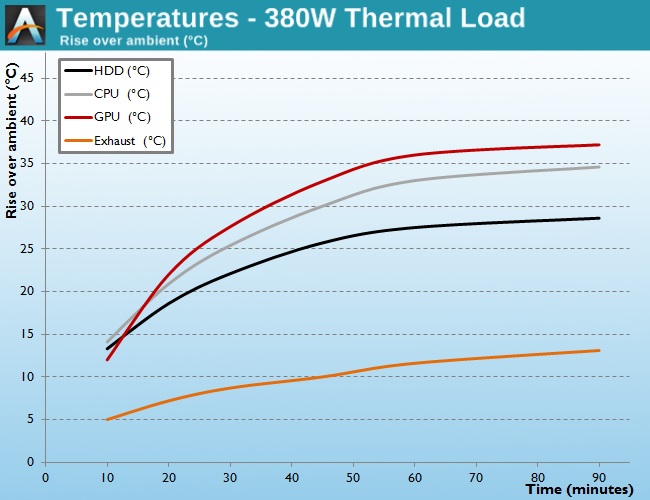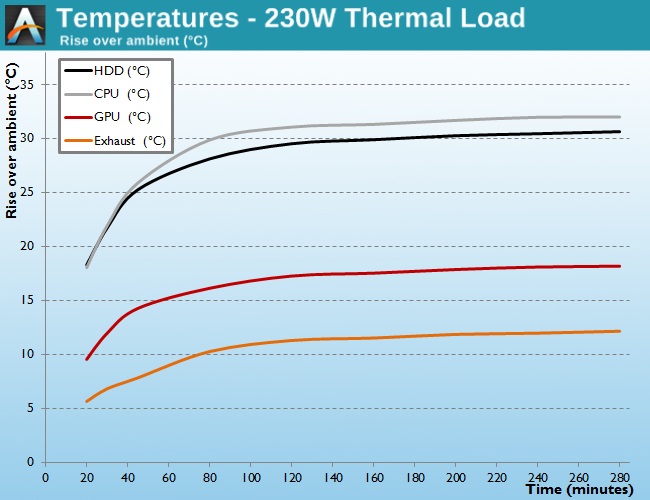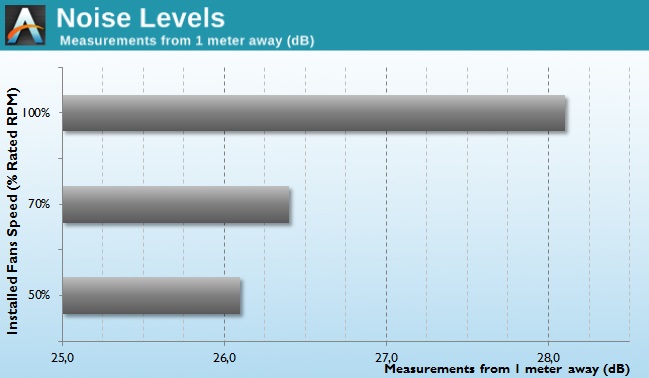Corsair Obsidian 250D Case Review
by E. Fylladitakis on January 21, 2014 12:00 PM EST- Posted in
- Cases/Cooling/PSUs
- Corsair
- Mini ITX
- Case
Test setup
We've reworked our computer case testing methodology to improve on how systems are tested, so as our first Mini-ITX case for the new setup we don't have comparitive results.
Professional testing requires the emulation of real-world situations but with repeatable results; thus, a perfectly controllable test setup and environment is desired, especially for comparable results. Testing the thermal performance of any case with a typical real-world setup technically limits the comparability of the results to this setup alone, as an active system interacts with its environment and the change of a single component can alter myriads of variables. As such, we developed synthetic loads that emulate the thermal output of real systems, with the benefit being that the outputs and loads are passive, steady and quantifiable. As such, the thermal testing now displays the thermal capabilities of the case alone, as if it would have to deal with the entire thermal load by itself, regardless of the system that would be installed inside it.
Laboratory data loggers are being used to monitor the PT100 sensors and control the safety relays, which are fully accessible via our custom software. Three such loads have been developed; the Mini-ITX version simulates a 150 W CPU, 30 W VRM, 20 W RAM and 1 × 120 W GFX card thermal load. Finally, 3.5" HDD dummy loads have also been created, with two of them installed in the Mini-ITX case. Each of them converts 30 W of electrical power to thermal, bringing the total thermal load of the ITX test setup up to 380 Watts. As such, the thermal load is very high and only the best of cases will be able to handle it for more than a few minutes. We are also performing a test with a thermal load of 230W, by removing the VRM and RAM heaters, one disk and using a low-profile, 50 W version GFX load, for comparison with compact Mini-ITX cases that cannot take a full size GFX card at all.
Thermal testing has been performed with all of the case's stock fan operating at maximum speed. Noise testing has been performed with a background noise level of 22.4dB(A).
Results and discussion
Despite the rather slow stock fans, the size and mass of the Corsair Obsidian 250D allows for excellent performance figures. The high-performance Mini-ITX case can easily tackle a passive thermal load of 380W, which is considered to be massive for a Mini-ITX system. Such is the thermal inertia of the case that the temperatures did not stabilize even after over an hour of testing. The temperatures beneath the GFX load are higher than around the CPU area, as the passive thermal load does not interact with its environment and the design expects a GFX cooler to be sucking air from the side panel of the case.
This means that while the Obsidian 250D will work optimally with any GFX card that has a fan, passive GFX cards will be receiving little to no aid by the bulk airflow of the case. This however also stands true for the components of the card that are not being cooled by the card's heatsink, such as secondary heatsinks (i.e. RAM, VRM), passive components, etc. The design also offers little airflow to the HDD cage, which however has ventilation openings on all sides, thus the temperatures remain at good levels during our testing. This also becomes apparent during our 230 Watt load test, as the temperature of the HDD load almost reaches that of the CPU area, despite being less than half the thermal magnitude.
As Corsair apparently installed two of the slowest, quietest fans they could find, the stock cooling of the Obsidian 250D largely relies on the size of the fans and the size of the case. The result is a very quiet running system, as the sound of the fans is only noticeable in an entirely silent room and while they are running at maximum speed. Most single 3.5" HDDs are noisier than the stock cooling fans of the Obsidian 250D. Reducing the speed of the fans does decrease the readings of our instruments, although the change was unnoticeable to a human ear from 1 meter away, as the system appeared entirely silent to begin with. To give you a practical equivalent of the 26.1 dB(A) that our meter registered one meter away from the Obsidian 250D, that's corresponding of a whisper at about 70 cm away.













52 Comments
View All Comments
Death666Angel - Wednesday, January 22, 2014 - link
"it can also backfire if the user is far too negligent"You can say that about every case. I've seen enough people coming to forums saying that their 1 year old PC suddenly freezes or has terrible performance or is super loud. Some time late we find out the CPU and/or GPU throttle and it is mostly the case of the the coolers being clogged by dust and debris. In my opinion, it is far easier to see and remove dust from filters than it is from the coolers themselves. So I'd still give this one a better grade than most other cases (note: many Silverstone ones have positive air pressure with filter designs which helps this a lot!).
E.Fyll - Thursday, January 23, 2014 - link
That's true. However, the clearance between the side panel filter and the graphics card fans is but a few mm in this case. Other cases could end up with clogged filters and yet, even if the air could not easily enter/exit the case, there would be room for air circulation. If the side panel filter of the Corsair 250D gets clogged however, I fear that the card will "suffocate", there is just not enough clearance for it to continue sucking air from the side of the card.Hrel - Wednesday, January 22, 2014 - link
Still prefer the Fractal Design Node 304faster - Wednesday, January 22, 2014 - link
Dimensions 350 mm ×277 mm ×290 mm(D × W × H)I could go convert this to inches, but it would be nice if the author did it for me.
Slomo4shO - Wednesday, January 22, 2014 - link
Welcome E! Thank you for the review. I would like to see a write up on the Cooler master Elite 110 as well in the near future :)bobbozzo - Wednesday, January 22, 2014 - link
Try a CPL (polarized, rotatable, filter), and rotate it until the glare (mostly) disappears.And/or move lights around.
Bob
bobbozzo - Wednesday, January 22, 2014 - link
Hi,I'm all for a consistent thermal load for repeatability, etc., but I worry that the noise levels will be misleading.
e.g. imagine 2 cases with similar fans in similar locations and similar airflow (direction, position, and CFM)...
with no component fans, they might sound about the same, but if case A has extensive noise dampening internally, and case B has none, then in the real-world, the components in case A would be harder to hear, resulting in a quieter system.
Perhaps your testing should be expanded to include some noise sources to simulate CPU and VidCard coolers (and maybe liquid cooling pumps).
The PSU fan is another possible source of noise; some cases (e.g. FD Node 304) now have the PSU mounted in the middle, so a noisy PSU might be quieter in such a case.
Thanks!
E.Fyll - Thursday, January 23, 2014 - link
Good thinking bobbozzo,Indeed, a case which has sound insulation will most likely result to lower noise levels than a case which has not (even though that is not always the case). However, I fear that currently I can only assess the noise level of the stock case and still end up with comparable results. You see, the sound pressure level, the position of the sound source, its frequency and several other factors are in play here. You could even use two configurations which generate similar acoustic pressure and yet end up with different results for each of them. Even if I do use some equipment to simulate the sound of a system, the results can vary depending on the configuration of the sound sources. For example, the liquid cooling pump of kit A could be reading less dB(A) than that of kit B during an unobstructed test, yet the sound wave could be at far higher frequency (the annoying whine that some kits make is such a wave) and the results would end up being significantly different if they were installed inside a case, depending on the case's size (echo), materials (rebound), the position of the pump and the insulation. Also, results can vary if there is difference between the sources of sound. For example, if the rest of the system remains the same and just a single fan becomes louder, it does not mean that the test results will just change scale, different cases will react differently.
However, I do consider it a very good idea and I will see what I can do about it. At the very least, I could perform a test with some additional noise sources, just as a basic reference.
Thank you for the advice. :)
just4U - Thursday, January 23, 2014 - link
Dustin not doing cases anymore? :( Hope he's still with Anandtech. Anyway, great first review there E. Would be nice if you could snag a modular PSU with ribbon cables for these case reviews. Their easy to work with and show what many of us might do in one of the builds.. Corsair should send you one! Or CoolerMaster.. It's free advertising for them after all :DJohnMD1022 - Thursday, January 23, 2014 - link
How about posting dimensions and weight in English as well as metric?I shouldn't need a calculator to read the review.